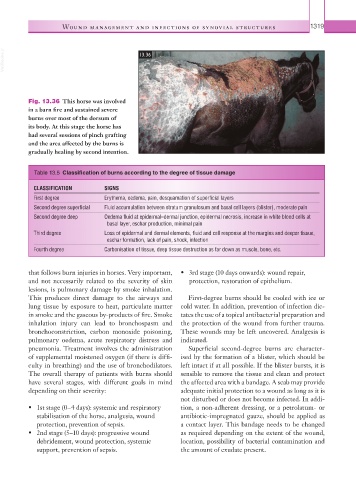Page 1344 - Equine Clinical Medicine, Surgery and Reproduction, 2nd Edition
P. 1344
Wound management and infections of synovial structures 1319
VetBooks.ir 13.36
Fig. 13.36 This horse was involved
in a barn fire and sustained severe
burns over most of the dorsum of
its body. At this stage the horse has
had several sessions of pinch grafting
and the area affected by the burns is
gradually healing by second intention.
Table 13.5 Classification of burns according to the degree of tissue damage
CLASSIFICATION SIGNS
First degree Erythema, oedema, pain, desquamation of superficial layers
Second degree superficial Fluid accumulation between stratum granulosum and basal cell layers (blister), moderate pain
Second degree deep Oedema fluid at epidermal–dermal junction, epidermal necrosis, increase in white blood cells at
basal layer, eschar production, minimal pain
Third degree Loss of epidermal and dermal elements, fluid and cell response at the margins and deeper tissue,
eschar formation, lack of pain, shock, infection
Fourth degree Carbonisation of tissue, deep tissue destruction as far down as muscle, bone, etc.
that follows burn injuries in horses. Very important, • 3rd stage (10 days onwards): wound repair,
and not necessarily related to the severity of skin protection, restoration of epithelium.
lesions, is pulmonary damage by smoke inhalation.
This produces direct damage to the airways and First-degree burns should be cooled with ice or
lung tissue by exposure to heat, particulate matter cold water. In addition, prevention of infection dic-
in smoke and the gaseous by-products of fire. Smoke tates the use of a topical antibacterial preparation and
inhalation injury can lead to bronchospasm and the protection of the wound from further trauma.
bronchoconstriction, carbon monoxide poisoning, These wounds may be left uncovered. Analgesia is
pulmonary oedema, acute respiratory distress and indicated.
pneumonia. Treatment involves the administration Superficial second-degree burns are character-
of supplemental moistened oxygen (if there is diffi- ised by the formation of a blister, which should be
culty in breathing) and the use of bronchodilators. left intact if at all possible. If the blister bursts, it is
The overall therapy of patients with burns should sensible to remove the tissue and clean and protect
have several stages, with different goals in mind the affected area with a bandage. A scab may provide
depending on their severity: adequate initial protection to a wound as long as it is
not disturbed or does not become infected. In addi-
• 1st stage (0–4 days): systemic and respiratory tion, a non-adherent dressing, or a petrolatum- or
stabilisation of the horse, analgesia, wound antibiotic-impregnated gauze, should be applied as
protection, prevention of sepsis. a contact layer. This bandage needs to be changed
• 2nd stage (5–10 days): progressive wound as required depending on the extent of the wound,
debridement, wound protection, systemic location, possibility of bacterial contamination and
support, prevention of sepsis. the amount of exudate present.

